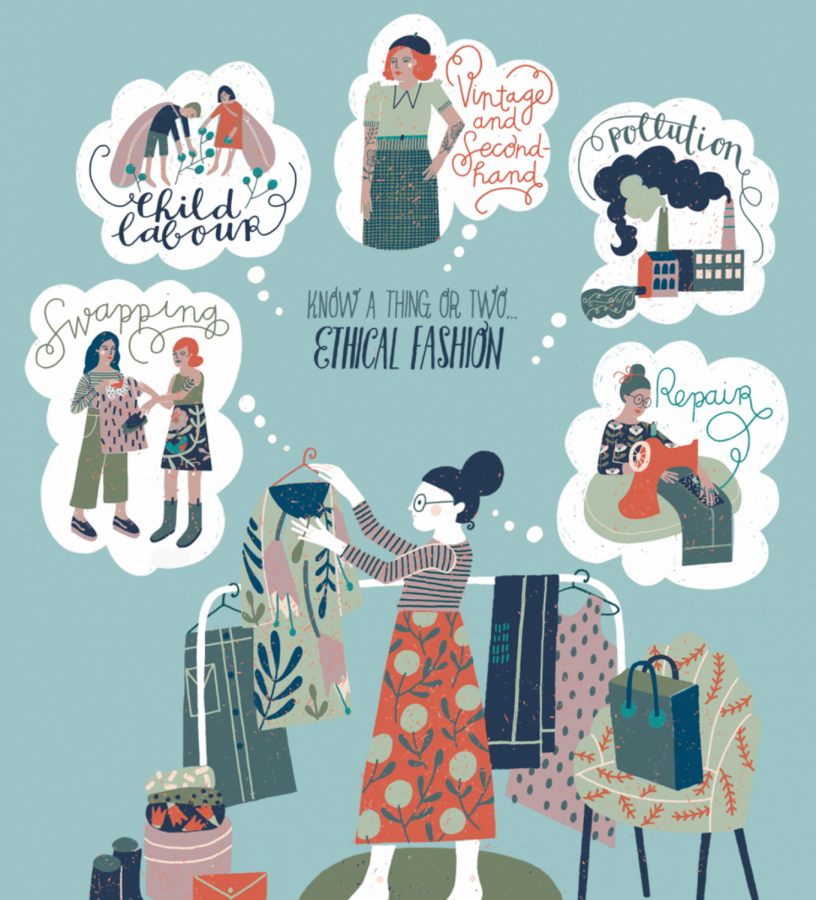Eco-Friendly Fashion 2021
January 28, 2021
Look at the tag on the inside of your shirt. Where was your shirt made? You only paid $9.99 for your Forever 21 top, so how cheap was it for the company to manufacture? Was it made in a factory that is up to date with it’s health and safety codes? Who sewed the shirt? Was it a machine or a single mother who is struggling to put food on her children’s plates? Was the employee paid fairly and given a break?
These are all questions that companies do not have to answer on the tag on the back of your shirt. After the Rana Plaza collapse in 2013 which killed over 1,100 innocent workers, along with the exposure of unfair treatment to employees in huge corporations, this should be concerning to us as consumers and humans. Not only does 93% of brands surveyed by Fashion Checker admit to not paying garment workers a living wage (Fashion Checker, 2020), but fast fashion is also the world’s third largest polluter, 35% of the ocean’s microplastics, and 8% of the world’s carbon emissions. Now what do we do with this information? The answer is purely to make conscious buying decisions.
With how quickly trends come and go, it is important that we are conscientious about what fashion we buy and where it comes from. Not only does making conscientious fashion choices help contribute to the end of unfair labor practices and earth altering pollution, but it gives you the ability to save money and have a unique wardrobe. Buying clothing secondhand is one of the best ways to take practice in eco-friendly fashion. Goodwill, Salvation Army, and other thrift stores are the best way to get use out of previously manufactured clothes, since they would otherwise go to the landfill. Even amidst a worldwide pandemic where people may not feel safe going to a consignment shop, buying secondhand clothing is still an option. This is thanks to the internet. Secondhand online retailers are the stores of the future. Apps like Depop, Ebay, Poshmark, and ThredUp, allow buyers to shop from previously loved clothing.
2021 trends can easily be thrifted or bought online. Button down tops, trench coats, corsets, funky pants, platform shoes, baggy jeans, and minibags can all be found at local thrift stores and online at a much lower price point than large retailers. A major predicted trend of 2021 is statement pieces. Shopping for bold pieces at the thrift store to be paired with a casual outfit is so easy to accomplish.
Other predicted trends of 2021 include sharp silhouettes and layering neutral colored pieces. Shopping in the 2-piece set section of your thrift store will find you amazing pant suits and blazers that can be paired with more modern pieces. Along with that, you can find many oversized pants and fun trousers in the men’s section. The most important thing to remember is that everything has potential to be styled correctly. Clothes sometimes look different on the hanger then they do when they are worn. If you see a piece that you are indecisive on, grab it. You will probably never find the exact item ever again. That’s what makes buying secondhand clothing so much more fun and unique to your own personal style.
Thrifting also is not your only option. There are also retailers making the eco-conscious change to their business. Sustainability is the up and coming fad of retailers. Companies such as Kotn, Pact, Happy Earth, Reformation, Patagonia, and Girlfriend Collective are all completely sustainable brands.
Swapping and trading clothes with your friends is also a great way to participate in having an eco-friendly closet. Although this may be a bit unconventional for some people, making your own clothes is also a great option. Crotchet and chunky knits are also predicted trends for 2021 fashion. Taking up knitting or crocheting could be a great quarantine hobby along with a way to have a one of a kind wardrobe. There are plenty of video tutorials online that can teach you everything you need to know.
With all of this information, the most effective thing you can do is to think before you buy. Along with that, spread awareness. Help others learn the facts so that they may also make conscientious buying decisions.



